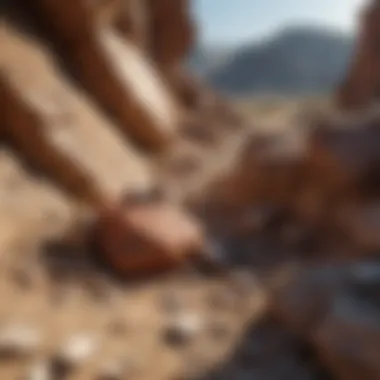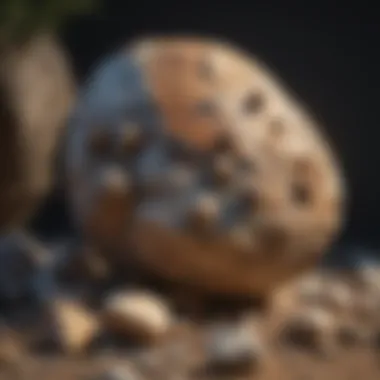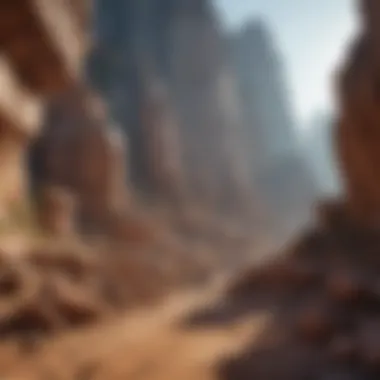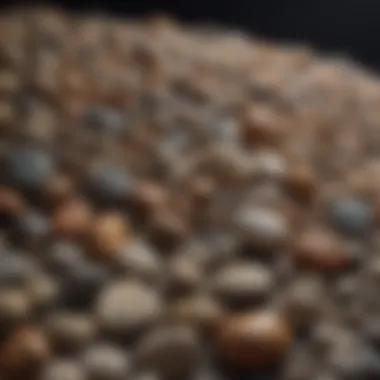Uncover Rockhounds Near You with This Comprehensive Guide


Rock and Fossil Identification
When delving into the world of rockhounding, a fundamental aspect is understanding the identification of rocks and fossils. Knowing the types of rocks and fossils is imperative for any enthusiast. Differentiating between sedimentary, igneous, and metamorphic rocks, as well as recognizing various fossil categories such as molds, casts, or trace fossils, lays the foundation for a fruitful collecting journey. The characteristics to look for are diverse, ranging from color and texture to hardness and streak. Familiarizing oneself with these key features sharpens the eye and aids in accurate identification. Moreover, utilizing specialized tools like geology hammers, magnifying glasses, and field guides enhances the identification process, making it more efficient and rewarding.
Understanding Rockhounding
Rockhounding is a captivating hobby that allows enthusiasts to explore the natural world and discover unique geological treasures. In this article, Understanding Rockhounding serves as a pivotal introduction to the intricate world of rock collecting. It delves into the essence of rockhounding, shedding light on the importance of respecting the Earth's geological formations and understanding the scientific and historical significance of rocks and minerals. By grasping the fundamentals of rockhounding, individuals can deepen their appreciation for the Earth's hidden wonders and embark on a journey of exploration and education.
What is Rockhounding?
Definition and Origins
The term rockhounding refers to the recreational activity of collecting rocks, minerals, and fossils from natural environments. Its origins can be traced back to early civilizations that valued gemstones and minerals for their aesthetic and spiritual properties. In the context of this article, the Definition and Origins of rockhounding provide a rich tapestry of heritage and fascination. By understanding the roots of rockhounding, enthusiasts can connect with ancient traditions of geological exploration and appreciate the intrinsic human fascination with Earth's treasures. The unique allure of Definition and Origins lies in its ability to bridge the past with the present, allowing rockhounds to engage with history while forging their path in the contemporary world of rock collecting.
Purpose and Appeal
The Purpose and Appeal of rockhounding lie in its ability to offer a multifaceted experience to collectors. Beyond the thrill of uncovering rare specimens, rockhounding provides individuals with a tangible connection to the Earth's geological processes and the vast timeline of our planet's evolution. This aspect is especially valuable in a world increasingly detached from nature, offering a grounding and humbling experience that rekindles a sense of wonder and curiosity. Moreover, the appeal of rockhounding extends to its inclusive nature, welcoming enthusiasts of all ages and backgrounds to explore, learn, and bond over a shared passion for rocks and fossils.
Benefits of Rockhounding
Educational Value
One of the key benefits of rockhounding is its educational value. Engaging in this hobby enables individuals to learn about geology, mineralogy, and paleontology in a hands-on and immersive way. By observing, collecting, and studying rocks, minerals, and fossils, enthusiasts deepen their knowledge of Earth's composition and history. This experiential learning fosters a better understanding of scientific concepts and encourages continuous exploration and discovery.
Therapeutic Benefits
In addition to its educational value, rockhounding offers therapeutic benefits to collectors. The act of sifting through rocks, feeling their textures, and observing their colors can have a calming and meditative effect. For many enthusiasts, rockhounding serves as a form of stress relief and a means of reconnecting with nature. Furthermore, the sense of accomplishment that comes from uncovering unique specimens boosts self-esteem and provides a sense of fulfillment, enhancing overall well-being.
Tools and Techniques
Essential Equipment
When delving into the world of rockhounding, having the right tools is essential for a successful and enjoyable experience. Basic equipment such as a rock hammer, chisel, magnifying glass, and field guide are indispensable for identifying and collecting specimens. The key characteristic of Essential Equipment lies in its practicality and functionality. These tools not only aid in the extraction and examination of rocks and minerals but also ensure the safety of collectors during their expeditions.
Best Practices
To maximize the rewards of rockhounding and minimize the impact on natural environments, adhering to best practices is crucial. Exploration ethics, such as obtaining landowner permission, leaving no trace, and following regulations, help preserve geological sites for future generations. By promoting responsible collecting habits and environmental stewardship, Best Practices in rockhounding ensure that the hobby remains sustainable and respectful towards the Earth and its invaluable geological resources.
Locating Rockhounds Near Me
Local Rock and Mineral Clubs
Benefits of Joining
In the realm of rockhounding, being part of a local rock and mineral club presents a myriad of advantages. These clubs provide a platform for enthusiasts to engage with one another, participate in group expeditions, attend educational seminars, and access exclusive resources. The key allure of joining such clubs lies in the opportunity to interact with a diverse range of collectors, from amateurs to professionals, and expand your knowledge base through shared experiences. The camaraderie fostered within these clubs enhances the rockhounding journey, offering support, encouragement, and a sense of community essential for personal growth and enjoyment in this hobby.
How to Find Clubs
Discovering local rock and mineral clubs is a pivotal step for individuals looking to immerse themselves in the world of rockhounding. One effective way to locate these clubs is through online directories specialized in rock and mineral organizations. Additionally, attending rock and gem shows often provides a platform to network with club representatives and learn about membership opportunities. Social media platforms and forums dedicated to geology and rock collecting also serve as valuable tools for connecting with local clubs and staying updated on their activities and events.


Online Communities
Forums and Social Media Groups
Online forums and social media groups tailored to rock and fossil collectors play a vital role in connecting enthusiasts from diverse locations. These virtual spaces act as hubs for sharing experiences, seeking advice, and engaging in vibrant discussions about all things related to rockhounding. The convenience of accessing information and insights at any time makes these platforms a popular choice for those unable to participate in physical club meetings regularly. By joining online communities, collectors can expand their network, learn new techniques, and stay abreast of the latest trends in the field.
Virtual Events and Workshops
Virtual events and workshops have become instrumental in the modern rockhounding scene, offering a dynamic platform for learning and engagement. These online gatherings provide opportunities to interact with experts, attend skill-building sessions, and virtually explore geologically significant sites worldwide. The flexibility and accessibility of virtual events make them an appealing choice for collectors looking to expand their knowledge base, participate in hands-on activities, and connect with enthusiasts across the globe.
Rock Shops and Events
Exploring Local Stores
Exploring local rock shops adds a tactile dimension to the rockhounding experience, allowing collectors to browse through curated collections, acquire new specimens, and seek advice from knowledgeable staff. These stores often serve as community hubs where enthusiasts gather to share stories, discuss finds, and participate in workshops or demonstrations. The appeal of local stores lies in the personalized service they offer, guiding collectors in their purchases and providing insights into the geological history of different specimens.
Attending Gem Shows
Gem shows represent a grand congregation of rock and mineral enthusiasts, featuring a diverse range of vendors, exhibitions, and educational activities. Attending these events not only provides access to rare and unique specimens but also offers a platform to meet experts, attend lectures, and immerse oneself in the vibrant culture of rockhounding. Gem shows serve as an ideal setting for networking, discovering new interests, and marveling at the beauty of Earth's geological treasures in a lively and immersive environment.
Connecting with Rockhounds
In the vast world of rockhounding, connecting with fellow enthusiasts holds significant importance for both amateur collectors and seasoned experts. This section delves into the various avenues through which rockhounds can expand their network, share knowledge, and foster a sense of community within the rock and fossil collecting realm.
Networking Opportunities
Collaborative Projects
Collaborative projects stand out as a cornerstone of the rockhounding community, offering individuals the chance to pool their expertise and resources towards common goals. By engaging in collaborative projects, rockhounds can undertake more substantial ventures, such as joint field expeditions, research endeavors, or even community outreach initiatives. The key characteristic of collaborative projects lies in their ability to leverage the diverse skills and interests of multiple individuals, resulting in enriched exploration experiences and a broader scope of findings. While collaborative projects enhance camaraderie and knowledge exchange among rockhounds, they also come with challenges such as coordinating schedules, balancing responsibilities, and ensuring effective communication throughout the project duration.
Field Trips and Excursions
Field trips and excursions remain vital components of rockhound networking opportunities, allowing enthusiasts to explore new terrains, uncover hidden geological treasures, and forge lasting bonds with fellow collectors. These excursions provide hands-on experience in identifying rocks, minerals, and fossils in their natural habitats, offering invaluable learning opportunities beyond traditional settings. The primary allure of field trips lies in their immersive nature, where participants can witness geological phenomena firsthand and engage in real-time discoveries. However, logistical considerations and environmental factors must be carefully addressed to ensure the safety and sustainability of these excursions.
Knowledge Sharing
Workshops and Seminars
Workshops and seminars play a pivotal role in facilitating the exchange of expertise and insights among rockhounds. These interactive sessions allow participants to delve into specific topics, techniques, or scientific advancements relevant to the field of rock and fossil collecting. The key characteristic of workshops and seminars is their focused approach towards knowledge dissemination, providing attendees with in-depth understanding and practical skills to enhance their collecting pursuits. While attending workshops and seminars can expand one's knowledge base and network within the community, limitations such as access barriers or conflicting schedules may hinder widespread participation.
Resource Sharing
Resource sharing emerges as another crucial aspect of knowledge dissemination in the rockhounding domain, enabling enthusiasts to access a repository of information, tools, and references shared by peers. By pooling resources and recommendations, rockhounds can overcome challenges, identify rare specimens, or learn about innovative techniques in the field. The unique feature of resource sharing lies in its collaborative nature, where individuals contribute to a collective wealth of knowledge, fostering a culture of cooperation and continuous learning. However, the success of resource sharing initiatives relies on active participation, credibility of shared information, and mechanisms to preserve and update shared resources.
Building a Community
Creating Local Meetups
Creating local meetups serves as a grassroots approach to building a strong community of rockhounds within a specific region or locality. These gatherings allow enthusiasts to interact face-to-face, showcase their collections, discuss common interests, and plan collaborative activities. The key characteristic of local meetups is their ability to foster a sense of belonging and camaraderie among like-minded individuals, leading to long-lasting friendships and shared experiences. While local meetups offer a platform for networking and socializing, challenges such as organizing logistics, ensuring inclusivity, and sustaining interest over time need to be addressed for continued community growth.


Online Group Activities
In today's digital age, online group activities have emerged as an essential medium for connecting rockhounds across geographic boundaries, enabling enthusiasts to engage in discussions, virtual events, and knowledge-sharing sessions remotely. The key characteristic of online group activities is their accessibility and convenience, allowing members to participate from anywhere with an internet connection. The unique feature of online group activities lies in their scalability, enabling large numbers of participants to interact simultaneously and contribute to diverse conversations. However, maintaining engagement, managing online dynamics, and ensuring security and privacy are critical considerations in fostering a vibrant online community of rock and fossil collectors.
Exploring Geological Wonders
In this ultimate guide to finding rockhounds near your location, exploring geological wonders holds a significant place. Rockhounding enthusiasts are always intrigued by the beauty and history that geological features hold. Understanding the geological formations and processes not only adds to the collection but also enriches the overall experience of rockhounding. Exploring geological wonders allows enthusiasts to witness the Earth's incredible creations up close, fostering a deep appreciation for the natural world.
Field Trips and Excursions
Planning Tips
When it comes to planning rockhounding trips, meticulous preparation is key. Planning tips are a crucial aspect of any successful rockhounding adventure. Enthusiasts need to consider factors such as location research, safety measures, and necessary equipment. Planning ahead ensures a smooth and organized expedition, maximizing the chances of discovering rare specimens. By outlining the objectives, setting a budget, and creating an itinerary, rockhounds can make the most of their field trips.
Notable Locations
Highlighting notable rockhounding locations is essential in guiding enthusiasts to prime collecting spots. Notable locations are renowned for their diverse geological offerings and unique mineral specimens. These spots attract rockhounds from around the world, making them hotspots for collecting and exploration. Each notable location has its own characteristics and mineral diversity, providing a variety of collecting opportunities. Understanding the geology of these areas enhances the rockhounding experience by offering a glimpse into the Earth's geological history.
National Parks and Reserves
Geological Marvels
National parks and reserves are treasure troves of geological marvels waiting to be explored. These natural landscapes contain stunning rock formations, ancient fossils, and geological wonders that captivate rockhounding enthusiasts. The geological marvels found within national parks offer a glimpse into the Earth's past, showcasing the forces of nature that have shaped the land over millions of years. Experiencing these marvels firsthand provides a deeper appreciation for the Earth's geological processes and the beauty of natural landscapes.
Regulations and Permits
Navigating the regulations and permit requirements of national parks and reserves is crucial for rockhounding enthusiasts. Understanding the rules and restrictions set in place helps protect the environment and preserves the integrity of the geological sites. Obtaining the necessary permits ensures that collectors can enjoy their outings responsibly and ethically. While regulations may pose challenges, they ultimately contribute to the conservation of these natural habitats for future generations of rockhounds.
DIY Rockhounding Adventures
Safety Guidelines
Safety guidelines are paramount in DIY rockhounding adventures to ensure a secure and enjoyable experience. Enthusiasts should prioritize safety by wearing appropriate gear, staying hydrated, and being aware of their surroundings. Following safety protocols minimizes risks associated with rockhounding activities and ensures a successful excursion. By adhering to safety guidelines, rockhounds can focus on their passion for collecting while staying prepared for unexpected situations.
Exploration Techniques
Mastering exploration techniques is fundamental for uncovering hidden gems during rockhounding adventures. Enthusiasts can employ various techniques such as rock identification, specimen extraction, and geological mapping to enhance their collecting endeavors. These exploration techniques enable rockhounds to discover minerals effectively and understand the geological context of their findings. By honing their exploration skills, collectors can broaden their knowledge and appreciation for the Earth's geological diversity.
Preserving Your Collection
Preserving your rock and fossil collection is a crucial aspect of rockhounding that epitomizes the essence of this article. The significance of preservation lies in safeguarding the integrity and longevity of your prized specimens. By implementing proper preservation techniques, collectors can ensure that their treasures remain in pristine condition for years to come. Preserving your collection not only maintains the aesthetic appeal of each piece but also preserves their scientific and historical value. As rock and fossil enthusiasts invest time and effort in acquiring these specimens, it becomes essential to protect and preserve them effectively.
Cleaning and Maintenance
Proper Care Practices
Proper care practices are the cornerstone of preserving any rock or fossil collection. The meticulous attention to cleaning and maintenance ensures that each specimen retains its beauty and authenticity. Using non-abrasive cleaning techniques and specialized tools, collectors can gently remove dirt and debris from delicate formations without causing any damage. The key characteristic of proper care practices is the emphasis on gentle cleaning methods that respect the fragility of rocks and fossils. This approach is widely favored in this article for its ability to extend the lifespan of specimens while keeping them in optimum condition. Proper care practices, with their focus on gentle yet effective cleaning methods, provide an indispensable solution for maintaining the quality and aesthetics of rock and fossil collections.
Preventive Measures


Preventive measures play a vital role in the long-term preservation of rock and fossil collections. By proactively mitigating potential risks such as display damage, environmental factors, and handling issues, collectors can protect their specimens from harm. The key characteristic of preventive measures is their proactive approach to safeguarding against common risks that can compromise the integrity of a collection. In this article, preventive measures are highlighted for their preventative strategies that address vulnerabilities and ensure the longevity of rock and fossil specimens. Implementing preventive measures serves as a proactive safeguard, reducing the likelihood of damage and preserving the value of the collection over time.
Display and Storage
Creative Showcase Ideas
Creative showcase ideas add a dynamic and visual dimension to displaying rock and fossil collections. Innovative display concepts can transform a collection into a captivating exhibition that showcases each specimen's unique beauty and significance. The key characteristic of creative showcase ideas is their ability to create engaging and visually appealing displays that captivate viewers. This article endorses creative showcase ideas for their capacity to enhance the aesthetic appeal of collections and create immersive experiences for enthusiasts. By exploring creative ways to present rock and fossil specimens, collectors can elevate the display of their collections and create impactful presentations that resonate with viewers.
Long-Term Preservation
Long-term preservation strategies are essential for safeguarding the longevity and condition of rock and fossil collections. By implementing proper storage methods, environmental controls, and preservation techniques, collectors can ensure that their specimens retain their quality over time. The key characteristic of long-term preservation is its focus on sustainable practices that protect specimens from deterioration and damage. This article emphasizes long-term preservation for its role in maintaining the integrity and value of collections. By adopting long-term preservation strategies, collectors can secure the longevity and authenticity of their rock and fossil specimens, ensuring their continued beauty and significance.
Documentation and Cataloging
Organizational Tips
Organizational tips are instrumental in effectively cataloging and managing rock and fossil collections. By establishing clear organizational systems, collectors can categorize and track specimens with ease, facilitating efficient retrieval and documentation. The key characteristic of organizational tips is their ability to streamline the collection management process and ensure systematic documentation. This article highlights organizational tips for their role in promoting structured and organized collection practices that enhance overall management efficiency. Implementing sound organizational tips enables collectors to maintain detailed records, track specimen provenance, and optimize storage solutions effectively.
Digital Archives
Digital archives offer a modern solution for cataloging and preserving rock and fossil collections in a digital format. By digitizing collection data, photographs, and related information, collectors can create comprehensive digital archives that provide easy access and secure storage. The key characteristic of digital archives is their capacity to centralize collection information and facilitate remote access for collectors. In this article, digital archives are commended for their convenience and versatility in preserving and documenting rock and fossil specimens. Embracing digital archives allows collectors to safeguard their collections digitally, ensuring accessibility, security, and longevity for their valuable specimens.
Further Resources and References
In the realm of rockhounding, accessing extensive and diverse resources and references is paramount for enthusiasts aiming to deepen their knowledge and understanding of rocks, minerals, and fossils. This article emphasizes the critical role that further resources and references play in enhancing the rock collecting experience. By delving into reputable sources, rockhounds can enrich their expertise, discover new specimens, and connect with a broader community of like-minded individuals.
Books and Publications
Authoritative Reads
Authoritative reads serve as foundational pillars in the world of rock collecting, offering valuable insights from leading experts in the field. Renowned for their accurate information and comprehensive coverage, authoritative reads provide rockhounds with reliable guidance on identifying, collecting, and preserving various specimens. Their meticulous research and detailed explanations make them indispensable for both beginner collectors and seasoned professionals, elevating the overall quality of information accessible to enthusiasts in this article. While some may find authoritative reads dense or technical, their in-depth content and authority in the subject make them a highly respected choice for those seeking to expand their knowledge base.
Specialized Journals
Specialized journals cater to the specialized interests of rockhounds by delving into niche topics and facilitating in-depth exploration of specific aspects of rock collecting. These journals offer a platform for researchers, collectors, and geologists to share their findings, discoveries, and analyses with a dedicated audience. Featuring detailed articles, cutting-edge research, and exclusive insights, specialized journals provide a deep dive into the latest trends, discoveries, and advancements in the field of rock collecting. While specialized journals may require a more specialized understanding and interest, they offer valuable depth and specificity that can significantly enhance the information available to enthusiasts searching for niche content in this article.
Online Tools and Databases
Identification Guides
Identification guides are essential tools for rockhounds aiming to accurately identify and classify different rocks, minerals, and fossils they encounter during their collecting expeditions. These guides showcase key features, characteristics, and properties of various specimens, equipping collectors with the necessary knowledge to distinguish between different types of rock formations. The visual aids, detailed descriptions, and comparison charts found in identification guides make them indispensable for rockhounds seeking to expand their collection with precision and accuracy. While some may find identification guides overwhelming due to the vast amount of information presented, their detailed content and practical utility make them an essential resource for enthusiasts navigating the diverse world of rockhounding in this article.
Virtual Museums
Virtual museums offer a unique and innovative way for rockhounds to explore curated collections, exhibitions, and displays of rocks, minerals, and fossils from around the world without leaving the comfort of their homes. These digital platforms provide immersive experiences that enable enthusiasts to virtually tour various geological wonders, access educational content, and learn about different specimens from a distance. With interactive features, multimedia resources, and engaging presentations, virtual museums offer an enriching experience for rock collectors interested in broadening their knowledge and appreciation of geology. While virtual museums may lack the tactile experience of physical museums, their accessibility, scope, and educational value make them a valuable addition to the resources available to enthusiasts in this article.
Educational Courses and Workshops
Learning Opportunities
Learning opportunities in the form of educational courses and workshops are invaluable for rockhounds seeking to deepen their understanding of geology, mineralogy, and paleontology. These programs offer structured learning experiences led by knowledgeable instructors who guide participants through theoretical concepts, practical techniques, and hands-on activities related to rock collecting. The interactive nature of learning opportunities encourages collaboration, engagement, and knowledge sharing among participants, fostering a vibrant learning environment that enhances the overall learning experience. While some may find learning opportunities rigorous or time-consuming, the comprehensive knowledge, skill development, and networking opportunities they provide make them a worthwhile investment for enthusiasts looking to expand their expertise in this article.
Certification Programs
Certification programs validate the expertise and skills of rock enthusiasts by offering formal recognition of their knowledge and proficiency in rockhounding practices. These programs often involve assessments, examinations, and practical demonstrations that assess participants' proficiency in various aspects of rock and fossil identification, collection, and preservation. By earning certifications, individuals demonstrate their commitment to excellence in the field and distinguish themselves as knowledgeable and skilled practitioners. While certification programs may require dedication and effort to complete, the professional credibility, achievement recognition, and validation they offer make them a valuable asset for enthusiasts seeking to establish their credentials and proficiency in this article.







